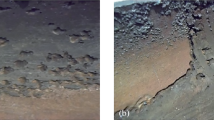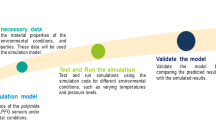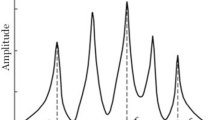Abstract
Underground pipelines are important infrastructure for transporting energy resources, particularly water and oil. Due to the high risk of damage and possible consequences, close monitoring of pipelines is a serious challenge for researchers and decision makers. Piezoelectric sensors/actuators are being used to monitor the physical characteristics of pipelines, including corrosion and crack. Piezoelectric ceramics as transmitters and/or receivers are connected to data concentrators in order to monitor the defects in pipelines. The performance and accuracy of this system highly depends on the accurate interpretation of the received electrical signals due to changing mechanical fields. However, due to the existence of two different fields, namely, electrical and mechanical, in this problem, simulation and interpretation of the damages occurring in pipelines is a consistent challenge. This paper proposes an equivalent electrical circuit model for a complete monitoring system which contains piezoelectric ceramics and a pipeline equivalent electrical circuit with corrosion defects and cracks through the pipeline. The pipeline is integrated with PZT sensor and actuator, in which PZT actuator generates waves along the thickness of the pipeline and its response is received by a PZT sensor. The proposed model approximates the electrical signal achieved by the PZT sensor to a complete health monitoring system. As the sensing signals in the present model are in one single field (i.e. electrical instead of mechanical and electrical), analysis and signal processing are more efficient, and the results are better understood. Numerical examples and, where applicable, simple tests have been presented to show the functionality and performance of the system.
Similar content being viewed by others
References
Y. W. Shin, M. S. Kim and S. K. Lee, Identification of acoustic wave propagation in a duct line and its application to detection of impact source location based on signal processing, Journal of Mechanical Science and Technology, 24(12) (2010) 2401–2411.
D. Kim and J. O. Kim, Generation and propagation of elastic waves on a pipe by open-shell transducers, The Journal of Mechanical Science and Technology, 25(10) (2011) 2475–2484.
M. Guan and W.-H. Liao, Studies on the circuit models of piezoelectric ceramics, International Conference on Information Acquisition, June (2004) 26–31.
V. Le Cam, F. Bourquin and L. M. Cottineau, A wireless sensor network for damage detection and health monitoring of cables, Proceedings of third European conference of structural control, Vienna, (2004).
P. Kabisatpathy, A. Barua and S. Sinha, Fault diagnosis of analog integrated circuits, Springer, (2005).
D. J. Leo, Engineering analysis of smart material systems, John Wiley and Sons, (2007).
T. R. Hsu, MEMS and microsystems, 2nd Edition, John Wiley and Sons, Hoboken, (2008).
D. J. Inman and J. Kim, Electrical modeling of piezoelectric ceramics for analysis and evaluation of sensory systems, IEEE Sensors Application Symposium, (2008).
A. S. Sedra and K. C. Smith, Microelectronic circuits, 5th edition, Oxford University Press, (2003).
M. H. Hussin and M. J. Kassim, Electrochemical studies of mild steel corrosion inhibition in aqueous solution by uncaria gambir extract, Journal of Physical Science, (2010).
Y. C. Hsu, N. B. Le and L. S. Jang, Simulation and experiment on St-cut quartz saw delay line response, International Symposium on Nano Science and Technology, (2007).
H. Fujino, K. Hitomi, J. Hashimoto and S. Umezawa, Fireresistant steel for building structure, British Standards Institution, (1993).
M. Cejkov, R. Groman and K. Sindoni, Designing an audio amplifier, Audio Engineering, (2009).
A. W. Leissa and M. S. Qatu, Vibration of continuous systems, McGraw Hill, (2011).
H. R. Shercliff and N. A. Fleck, Effect of specimen geometry on fatigue crack growth in plane strain, Fatigue Fract. Engng Mater. Struct. 13(3) (1990) 287–296.
S. Dezfouli and A. Zabihollah, Structural health monitoring of buried pipelines under static dislocation and vibration, Proceeding of 2010 IEEE/ASME International conference on mechatronics and embedded systems and application, July, 5–17, IEEE computer society press, Los Alamitos (2010), doi: 10.1109/MESA.2010.5552052.
Author information
Authors and Affiliations
Corresponding author
Additional information
Recommended by Associate Editor Jun-Sik Kim
A. Zabihollah received his PhD in mechanical engineering from Concordia University, Montreal, Canada in 2007. He is the author of over 35 publications on smart structures, vibration suppression and design optimization. Dr. Zabihollah currently is with international campus of Sharif University of Technology on Kish Island.
Mohadese Kolbadinejad received her M.Sc. in mechatronics engineering from Sharif University of Technology University, Kish, Iran in 2012. She works on smart structures like PZT with employing different approaches for fault detection of the structures.
Amir A. Khayyat recied his PhD from University of Manitoba in 2000. He joined the department of aerospace engineering in Sharif University in 2001. His research interests include robotics, fuzzy and optimal control.
Masihollah Mahmoud Pour received his M.Sc. degree in Mechanical Engineering from the Sharif University of Technology, International of Kish Island, Iran, in 2012. His research interest is MEMS. He is currently in the Research Institute of Petroleum Industry of Iran.
Rights and permissions
About this article
Cite this article
Kolbadinejad, M., Zabihollah, A., Khayyat, A.A.A. et al. An equivalent electrical circuit design for pipeline corrosion monitoring based on piezoelectric elements. J Mech Sci Technol 27, 799–804 (2013). https://doi.org/10.1007/s12206-013-0130-y
Received:
Revised:
Accepted:
Published:
Issue Date:
DOI: https://doi.org/10.1007/s12206-013-0130-y




